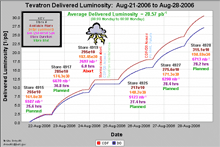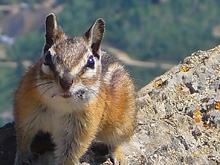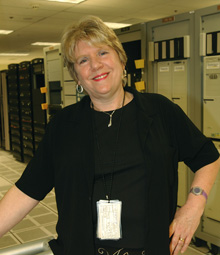
|
Wednesday, September 6
3:30 p.m. Director's Coffee Break - 2nd floor crossover
4:00 p.m. Fermilab Colloquium - 1 West
Speaker: D. Groom, Lawrence Berkeley National Laboratory
Title: A Simplistic View of Hadron Calorimetry
*There will be no
Fermilab ILC R&D Meeting
Thursday, September 7
2:30 p.m. Theoretical Physics Seminar - Curia II
Speaker: T. Becher, Fermilab
WH-3NW
Title: Threshold Resummation in Momentum Space from
Effective Field Theory
3:30 p.m.
DIRECTOR'S COFFEE BREAK -
2nd Flr X-Over
4:00 p.m. Accelerator Physics and Technology Seminar - Curia II
Speaker: J. Norem, Argonne National Laboratory
Title: RF Breakdown and High Gradient Limits
Click here for a full calendar with links to additional information. |



Wednesday, September 6
-Portabello Harvest Grain
-Santa Fe Chicken Quesadilla
-Teriyaki Chicken w/Vegetables
-Beef Stroganoff
-Triple Decker Club
-Assorted Slice Pizza
-Pesto Shrimp Linguini w/Leeks & Tomatoes
Wilson Hall Cafe Menu
|

Wednesday, September 6
Lunch
-Salmon Fillet w/Watercress Sauce
-Orzo w/Pine Nuts, Tomatoes and Arugula
-Chocolate Raspberry Cake
Thursday, September 7
Dinner
-Melon and Prosciutto
-Pork Tenderloin w/Madeira Sauce
-Vegetables of the Season
-Marzipan Cake
Chez Leon Menu
Call x4598 to make your reservation.
|


|
 |
| Breaking records: What's going right with the Tev?
|
|
|
 |
|
Integrated luminosity for the week of August 21 set a record with 28.57 inverse picobarns. A new record is expected this week. (Graphics courtesy of Brian Drendel.)
|
|
|
Anyone who works with antiproton accelerators knows the story: Physicists make pbars, physicists inject pbars, physicists lose pbars. But for the Tevatron, the story's been changing. Thanks to intensive pbar studies done last winter--and to brilliant Tevatron adjustments from December to March--the Accelerator Division is making and keeping antiprotons better and longer than ever.
"Pbars are our limiting factor in luminosity," said Brian Drendel, Accelerator Division run coordinator. "We've gotten faster and more efficient when it comes to making, storing and transferring them." With 28.57 inverse picobarns last week, and 109 inverse picobarns last month, the improvements have helped the Tevatron consistently break records for integrated luminosity, and new highs are expected again this week.
Drendel says a number of things led to the improvement. "You can't point to any one, golden thing that made this happen," he said. "It was really a combination of things going right." The Accelerator Complex has improved in a few major areas:
Improved machine reliability: "Once something breaks, it's like when you trip and you fall," said Drendel. "You might try to hurry when to get back up, then fall again." Since physicists spend time building up the next store while the current store is circulating, losing a circulating store can have a domino effect on integrated luminosity--it guarantees future stores won't be as rich with pbars because they'll be made in a hurry as physicists rush to reduce downtime.
Starting with more: Antiprotons are not easy to make. Physicists have to hurl protons at a nickel target and collect the twenty-in-a-million antiprotons that fly off. Increasing the number of protons sent to the target, and the improving methods for collecting the antiprotons, have improved the size of stores.
Moving and storing better: Once antiprotons are collected, they need to be stacked, or stored, until there are enough to shoot into the Tevatron. The antiproton storage ring, otherwise known as the "Recycler," has gotten better at holding antiprotons without losing them. Physicists have also gotten more efficient at moving the pbars to the Recycler. This makes it easier to build a sizable store of antiprotons quickly.
Collisions in the right place: Improved electrostatic separators prevent collisions outside the designated collision zones. Fewer pbars are wasted as they circulate in a helical orbit through the "dead zone" of the Tevatron ring. This helps build momentum because if pbars last longer, stores last longer. Physicists have more time to build the next store, which contributes future luminosity.
Luck: Some things, like lightning, are beyond the control of Tevatron operators. "If any one small part of the long Accelerator Complex goes down, we don't integrate luminosity as well," said Drendel. "But sometimes, things just go right."
You can find luminosity charts and updates on the Accelerator Division Website.
--Siri Steiner
|

Physorg.com,
September 1, 2006:
Sterile neutrinos and the search for warm dark matter
Matteo Viel, a research fellow at the Institute of Astronomy in Cambridge, England, believes that particle physics and cosmology could be more compatible as scientists work toward understanding the origins and the nature of our universe.
And, with an international team that includes scientists from France and Italy, as well as a theorist from CERN in Switzerland, Viel has produced a paper that may just do that. It is titled "Can Sterile Neutrinos Be Ruled Out as Warm Dark Matter Candidates?", and it addresses the possibility of a less-standard view of the universe. It was published in Physical Review Letters on August 17.
Read More
|
|  |

| Computing around the clock |
This week's column is written by Computing Division Head Vicky White.
Last week, a few computing hiccups reminded me of how dependent everyone has become on "being online" all the time. I got an early morning call from site security telling me that someone reported the computer network being down. Clearly, someone felt this was a matter of such great urgency and potential impact that site security must be notified, just as if a tree had fallen across the road!
In the end, it turned out to be a misstep through the helpdesk off-hours menu at x2345, which we are trying to correct. The problem was an unusual failure of the dhcp servers that supply dynamic network addresses. Meanwhile people had sprung into action around 5 a.m. to fix the service. For all of our 24/7 supported services -- networks, email, web servers and more -- automated monitoring systems call in dedicated professionals who keep the machines and services up and running all the time.
Later in the week Fermilab was "blacklisted" by SpamCop, a watchdog group which provides lists of senders for spam filtering. The cause was likely our valiant attempts to deliver all mail; under a severe spam attack, this can result in sufficient spam coming back out from our site to make us look like spammers. Many institutions "whitelist" Fermilab and accept our mail anyway. But for a few hours on this day, mail to CERN (and elsewhere) was failing. Jack Schmidt and his team soon devised clever workarounds and had the problem fixed. We must work even harder to figure out how to further cut down spam without turning away valid mail.
Keeping all of this computing up and running around the clock is a challenge; but it's one we enjoy, even in weeks like last week. In a future column, I'll have more about scientific computing and data movement that also has to be kept humming along, around the clock and around the world.
Next week's column will feature Jim Strait of the Particle Physics Division.
|

 |
Wild thing: DZero's Greg Landsberg took this picture at the top of a hiking trail in Aspen, Colorado, where he was attending an LHC-related workshop. "The chipmunk was really curious when I started to photograph him some 6 feet away," he writes. "For a moment he disappeared and then popped out of a rock barely two feet from me."
|
|

Benefits survey
Would you like to give feedback about your benefits? The Benefits Office invites you to participate in a survey, and will use your feedback to enhance customer service and review benefit offerings. You may complete the survey electronically or come to the Benefits Office to pick up a paper copy. The survey ends September 8.
Tour and lecture at Waubonsee
Waubonsee Community College offers a lecture at and tour of the new
Waubonsee Science Building at the Sugar Grove campus on September 13, from
7-9 p.m. Dr. Seth Stein of Northwestern University will talk about giant
earthquakes. Refreshments will be served. Space is limited, so please call
Community Education at 630-466-2360 to reserve a free ticket.
More information.
Hadronic Shower Simulation Workshop starts tomorrow
A hadronic showers workshop will take place at Fermilab from September 6 through September 8. The workshop will focus on the understanding and simulation of hadronic showers
in calorimeters, in shielding, in the atmosphere and the ocean.
If you would like to participate, please register as soon as possible. There is no registration fee.
Upcoming Activities
|
|



